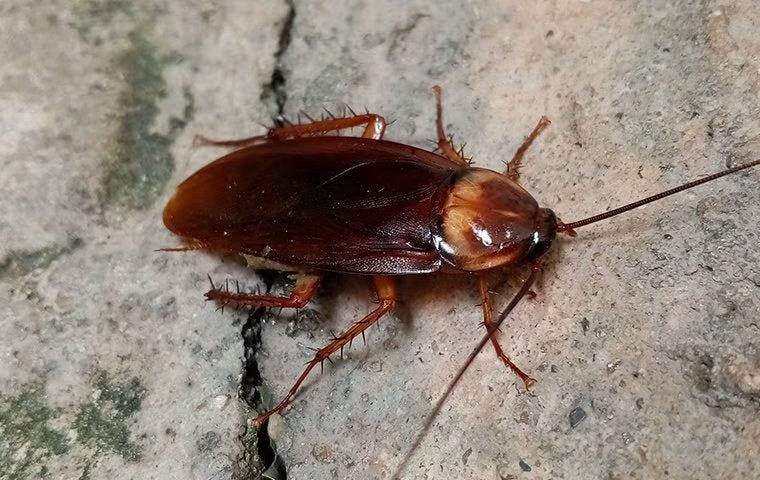American Cockroaches
Periplaneta Americana
American cockroaches are also known as waterbugs or palmetto bugs. Since they thrive in tropical regions, they are very abundant in South Florida.

What American cockroaches look like?
American cockroaches are also known as waterbugs or palmetto bugs. Since they thrive in tropical regions, they are very abundant in South Florida.
What is the life cycle of an American cockroach?
The female American cockroach produces on average 21 egg cases in a lifetime at a rate of one per week. During cold weather this interval may lengthen. Each capsule, also known as the ootheca, contain 16 eggs. Females often glue the ootheca to a hidden surface.
The egg capsule contains enough water for the embryos to complete development. Under favorable conditions the nymphs will hatch out in 50 days. The nymphs will molt 9 to 13 times before reaching maturity. The first few molts occur in monthly intervals and later molts at longer intervals. Initially the nymphs are grayish brown in color. After subsequent molts they become more reddish brown. The nymphal stage is greatly influenced by temperature and can take 160 to 900 days to complete (on average 600 days). At room temperature adults can live up to 15 months.
What is the life cycle of an American cockroach?
The female American cockroach produces on average 21 egg cases in a lifetime at a rate of one per week. During cold weather this interval may lengthen. Each capsule, also known as the ootheca, contain 16 eggs. Females often glue the ootheca to a hidden surface.
The egg capsule contains enough water for the embryos to complete development. Under favorable conditions the nymphs will hatch out in 50 days. The nymphs will molt 9 to 13 times before reaching maturity. The first few molts occur in monthly intervals and later molts at longer intervals. Initially the nymphs are grayish brown in color. After subsequent molts they become more reddish brown. The nymphal stage is greatly influenced by temperature and can take 160 to 900 days to complete (on average 600 days). At room temperature adults can live up to 15 months.
Where do American cockroaches live?
In South Florida American cockroaches, along with other Periplaneta species, live outdoors in hollow trees, palm trees, mulch, and woodpiles. These roaches prefer moist and shady environments, so they also live in the sewers, storm drainage systems, and near garbage. In northern states American cockroaches also inhabit steam tunnels, boiler rooms, basements, greenhouses, and large institutional facilities.
How did I get American cockroaches?
When conditions are unfavorable American cockroaches may move indoors. In South Florida these roaches seek shelter during heavy rainstorms or extreme heat. It is a misconception that American roaches enter homes to find food or water. They are basically running for their lives when they move indoors. The American cockroach is a peridomestic species because it can live indoor or outdoors.
For the most part American cockroaches die from dehydration once indoors. These roaches cannot survive without moisture, so we often find them dead in the middle of floor. However, the kitchen and the bathroom are two key areas that can provide sufficient moisture and protection for American cockroaches to survive. More so if there is excess moisture from a leaky pipe. American roaches can also become established in the attic if there is enough moisture from a roof leak or condensation from an AC pipe.
These conducive conditions create the perfect storm for American cockroaches to survive indoors. When this happens, they start breeding within the walls of your home.
American cockroaches can also move indoors when there is a plumbing issue such as a broken pipe, uncapped pipe, deteriorated wax ring, and a broken vent stack. These roaches can also get inside when the water in the drains or the toilets dry out.
How dangerous are American cockroaches?
Because American roaches find harborage in unsanitary areas such as near decaying matter, garbage, drains, and sewers they pick up germs from these places and transfer them to food and food preparation surfaces. Disease causing microorganisms can cause diarrhea, vomiting, stomach cramps, fever, nausea, chills, headaches, and blood in the stool.
Some people may have allergic reactions when exposed to cockroach feces, saliva, and other bodily secretions. Others may suffer from asthma attacks when exposed to these allergens.
If you encounter several cockroaches in a week or during the day, it is possible there is an infestation. Contact a South Florida pest control company if you suspect roaches are living inside your home.
How do you get rid of American cockroaches?
The first step in the elimination of an American cockroach infestation from a home is to remove the conducive condition that provides harborage. Any condition that generates moisture should be corrected by the homeowner.
The second step is to hire a pest control professional that has the knowledge and the tools to apply residual insecticides to key areas where American cockroaches are known to breed. GOTBUGSIKILL technicians are trained to do targeted applications of long-lasting dusts and granular baits in wall voids, under cabinets, attic, laundry room, and garage. The application of liquid sprays on baseboard does not work for American roaches.
How do I prevent American cockroaches?
Exclusion and moisture correction are the key answered to this question.
The best way to prevent American cockroaches is to seal potential entry points. We recommend homeowners to caulk gaps around pipes and other utility lines, caulk any crack and crevices that lead inside, seal gaps along the foundation, replace garage door seals, install door sweeps, replace damaged weather stripping, and repair broken vents.
Lastly make sure to eliminate excessive moisture around the home. It is important to fix any leaky pipes, roof leaks, clean debris from gutters, repair broken sprinklers, and make sure water from the AC condensation drain does not pool next to the foundation.